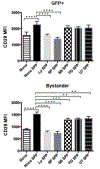Noncontiguous Protein Interaction Domains in Osteopontin Contribute to Enhance HIV-1 Replication
- PMID: 31773048
- PMCID: PMC6879059
- DOI: 10.15406/jhvrv.2014.01.00003
Noncontiguous Protein Interaction Domains in Osteopontin Contribute to Enhance HIV-1 Replication
Abstract
Osteopontin (OPN) is a proinflammatory cytokine produced by T-cells, macrophages, osteoclasts, and several other cell types, which confers immunity to many intracellular pathogens. OPN was first identified as an early marker of cellular activation of T-lymphocytes and subsequently was shown to play a role in cancer through its ability to promote cell survival and inflammation. OPN levels are elevated in the plasma and cerebrospinal fluid of HIV-infected individuals and even more so in those suffering from HIV-related neurocognitive impairment. The infiltration of monocytes and macrophages both infected and uninfected into the brain is the first step in HIV pathogenesis of the central nervous system. Inhibition of OPN in macrophages significantly impairs HIV replication. In an effort to identify and understand the role of OPN in the neuropathogenesis of HIV infection, we are using a combination of in vitro, ex vivo and in vivo approaches. In this study we have used a molecular approach and a surrogate cell culture model to identify the domains of OPN that are required to enhance HIV replication. We found that N- and C-terminal fragments, encoding multiple motifs including sequences involved in binding integrins and CD44, a domain know to promote adhesion contribute to OPN's ability to increase HIV replication. Use of inhibitors against c-Jun N-terminal kinase (JNK) and phosphoinositide 3-kinase (PI-3K) impaired the ability of OPN to increase the integrin subunit 1 or CD29 on the surface of HIV-infected and bystander cells. These results suggest that multiple OPN-regulated cellular pathways are commandeered by HIV to promote productive replication and cell-to-cell spread.
Keywords: Beta-1 integrin; CD29; CD44; JNK; Phosphoinositide-3 kinase; Secreted phosphoprotein-1; Syncytia.
Figures





References
-
- Wang KX, Denhardt DT (2008) Osteopontin: Role in immune regulation and stress responses. Cytokine Growth Factor Rev 19(5–6): 333–345. - PubMed
Grants and funding
LinkOut - more resources
Full Text Sources
Research Materials
Miscellaneous
